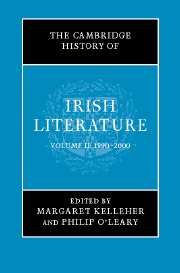Book contents
- Frontmatter
- Introduction
- 1 Literature and politics
- 2 The Irish Renaissance, 1890–1940: poetry in English
- 3 The Irish Renaissance, 1890–1940: prose in English
- 4 The Irish Renaissance, 1890–1940: drama in English
- 5 The Irish Renaissance, 1880–1940: literature in Irish
- 6 Contemporary prose and drama in Irish 1940–2000
- 7 Contemporary poetry in Irish: 1940–2000
- 8 Contemporary poetry in English: 1940–2000
- 9 Contemporary prose in English: 1940–2000
- 10 Contemporary drama in English: 1940–2000
- 11 Cinema and Irish literature
- 12 Literary historiography, 1890–2000
- Afterword: Irish-language literature in the new millennium
- Afterword: Irish literature in English in the new millennium
- Guide to major subject areas
- Index
- References
3 - The Irish Renaissance, 1890–1940: prose in English
Published online by Cambridge University Press: 28 March 2008
- Frontmatter
- Introduction
- 1 Literature and politics
- 2 The Irish Renaissance, 1890–1940: poetry in English
- 3 The Irish Renaissance, 1890–1940: prose in English
- 4 The Irish Renaissance, 1890–1940: drama in English
- 5 The Irish Renaissance, 1880–1940: literature in Irish
- 6 Contemporary prose and drama in Irish 1940–2000
- 7 Contemporary poetry in Irish: 1940–2000
- 8 Contemporary poetry in English: 1940–2000
- 9 Contemporary prose in English: 1940–2000
- 10 Contemporary drama in English: 1940–2000
- 11 Cinema and Irish literature
- 12 Literary historiography, 1890–2000
- Afterword: Irish-language literature in the new millennium
- Afterword: Irish literature in English in the new millennium
- Guide to major subject areas
- Index
- References
Summary
The Irish Literary Revival defined itself in part as an abstention from the English literary tradition, and this included the ‘English novel’, using the term in a generic as well as national sense. After all, it was thought by some Irish cultural nationalists that the English novel written by Irish novelists had tended to demean Ireland, perpetuating in the middle and late nineteenth century a view of the island that Yeats acidly referred to as the ‘humourist’s Arcadia’. In any case, the kinds of stories, characters, themes and literary styles that the Revivalists wished to resuscitate or invent did not suggest the novel as their best vehicle, and so the novel did not fare as well as poetry and drama once the Revival got under way. The Revival thought of itself as returning to the past to achieve a beginning, so its exponents and promoters paid little attention to the Irish Victorian novel which continued through the 1890s and into the Edwardian decade and beyond. In our own day, literary historians of the period have maintained this inattention. The Revival has retained its centrality and while this has permitted consideration of a counter-Revival (see, for example, three sections so titled in the third volume of the Field Day Anthology of Irish Writing, 1991), creditable Irish writing that neither promoted nor repudiated the Revival has been neglected. The ‘English connection’ in literature and society has been ignored. Yet despite the Home Rule movement, the Irish-Ireland movement, the republican movement (and Easter 1916), the setting up of the Free State in 1922 and the later declaration of the Republic, relations between Ireland and Britain continued, with their direct and indirect literary and cultural expressions, but find little or no place in the story of Irish fiction.
- Type
- Chapter
- Information
- The Cambridge History of Irish Literature , pp. 113 - 180Publisher: Cambridge University PressPrint publication year: 2006
References
- 1
- Cited by

